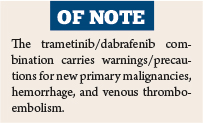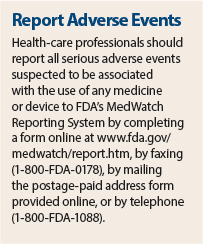On January 9, 2014, the combination of trametinib (Mekinist) and dabrafenib (Tafinlar) was granted accelerated approval for the treatment of patients with unresectable or metastatic melanoma with BRAF V600E or V600K mutations as detected by a U.S. Food and Drug Administration (FDA)-approved test.1,2 The approval of the combination is based on demonstration of durable response rate. Improvements in disease-related symptoms and overall survival have not yet been shown for the combination. Both drugs were approved for use as single agents in this setting in May 2013.
Efficacy Findings
Approval of the combination is based on findings in an open-label trial in which 162 patients with no prior exposure to BRAF or MEK inhibitors were randomized to receive trametinib at 2 mg (n = 54) or 1 mg (n = 54) orally once daily plus dabrafenib at 150 mg orally twice daily or dabrafenib at 150 mg alone (n = 54).1-3 Patients had a median age of 53 years, 57% were male, > 99% were white, 66% had Eastern Cooperative Oncology Group performance status of 0, 67% had M1c disease, 54% had normal lactate dehydrogenase levels, 8% had a history of brain metastases, and 81% had not received prior therapy for unresectable or metastatic disease; 85% had BRAF V600E mutations and 15% had BRAF V600K mutations.
Median follow-up was 14 months. Investigator-assessed overall response rate, the primary endpoint, was 76% in patients receiving trametinib at 2 mg plus dabrafenib (including complete response in 9%), vs 54% in those receiving dabrafenib alone (including complete response in 4%). Median duration of response was 10.5 vs 5.6 months.
On independent radiology review committee assessment, objective response rates were 57% (complete response in 9%) vs 46% (complete response in 7%) with median duration of response of 7.6 months in both groups. Outcomes were similar in patients with BRAF V600E mutations and BRAF V600K mutations.
How They Work
Trametinib and dabrafenib target two different tyrosine kinases in the RAS/RAF/MEK/ERK pathway. Use of trametinib and dabrafenib in combination resulted in greater growth inhibition of BRAF V600 mutation–positive melanoma cell lines in vitro and prolonged inhibition of tumor growth in BRAF V600 mutation–positive melanoma xenografts compared with either drug alone.
Trametinib is a reversible inhibitor of MEK1 and MEK2 activation and MEK1 and MEK2 kinase activity. MEK proteins are upstream regulators of the extracellular signal-related kinase (ERK) pathway, which promotes cellular proliferation. BRAF V600E mutations result in constitutive activation of the BRAF pathway, which includes MEK1 and MEK2. Trametinib inhibits BRAF V600 mutation–positive melanoma cell growth in vitro and in vivo.
Dabrafenib is an inhibitor of some mutated forms of BRAF kinases, and some mutations in the BRAF gene, including those that result in BRAF V600E, can result in constitutively activated BRAF kinases that stimulate tumor cell growth. Dabrafenib inhibits BRAF V600 mutation–positive melanoma cell growth in vitro and in vivo.
How the Combination Is Used
The recommended dose of the combination is trametinib at 2 mg once daily and dabrafenib at 150 mg twice daily, taken at least 1 hour before or 2 hours after a meal.
No dose modifications of either drug are required for new primary noncutaneous malignancies. Dabrafenib should be permanently discontinued in patients who develop RAS mutation–positive noncutaneous malignancies.
Concurrent administration of strong inhibitors of CYP3A4 (eg, ritonavir, clarithromycin, ketoconazole) or CYP2C8 (eg, gemfibrozil) and strong inducers of CYP3A4 (eg, carbamazepine, phenobarbital, St. John’s wort) or CYP2C8 (eg, rifampicin) should be avoided when trametinib and dabrafenib are used in combination. Concomitant use of the combination with agents that are sensitive substrates of CYP3A4, CYP2C8, CYP2C9, CYP2C19, or CYP2B6 (eg, tacrolimus, imatinib, anastrozole, paclitaxel, sorafenib), may result in loss of efficacy of these agents.
Safety Profile
Patients with abnormal left-ventricular ejection fraction, history of acute coronary syndrome within 6 months, current evidence of class II or greater congestive heart failure (New York Heart Association), history of retinal pigment epithelial detachment or retinal vein occlusion, QTc interval ≥ 480 msec, treatment refractory hypertension, uncontrolled arrhythmias, history of pneumonitis or interstitial lung disease, or a known history of glucose-6-phosphate dehydrogenase deficiency were excluded from the trial supporting approval of the combination.
The most common adverse events of any grade in patients receiving trametinib at 2 mg or 1 mg in combination with dabrafenib were pyrexia (71% and 69% vs 26% with dabrafenib alone), chills (58% and 50% vs 17%), fatigue (53% and 57% vs 40%), rash (45% and 43% vs 53%), nausea (44% and 46% vs 21%), and vomiting (40% and 43% vs 15%). The most common grade 3 or 4 adverse events were pyrexia (5% and 9% vs 0%), nausea (2% and 6% vs 0%), renal failure (7% and 0% vs 0%), back pain (5% and 0% vs 2%), and hemorrhage (5% and 0% vs 0%).
Serious side effects included bleeding, clot formation, heart failure, skin problems, and eye problems. The development of a new squamous cell carcinoma of the skin, a known adverse effect of dabrafenib, was reduced from 19% in the dabrafenib-alone group to 7% in the combination group.
Adverse events led to dose reduction in 49% of combination patients, with the most common reasons being pyrexia, chills, and nausea, and dose interruption in 67%, with the most common reasons being and pyrexia, chills, and decreased ejection fraction. Adverse events led to permanent discontinuation of study treatment in 13% of combination patients, with the most common cause being pyrexia (4%).
Fever was more common and more severe with the combination vs dabrafenib alone. QTcF prolongation to > 500 msec occurred in 4% of patients receiving trametinib at 2 mg/dabrafenib and in 2% of dabrafenib-only recipients. QTcF increased more than 60 msec from baseline in 13% of the combination group and in 2% of the dabrafenib group.
In the entire safety population of 202 patients, clinically important adverse events that occurred with a frequency < 10% in combination recipients included blurred vision, transient blindness, stomatitis, pancreatitis, asthenia, cellulitis, folliculitis, paronychia, pustular rash, skin papilloma, palmar-plantar erythrodysesthesia syndrome, hyperkeratosis, hyperhidrosis, and hypertension.
The combination of trametinib and dabrafenib carries warnings/precautions for new primary cutaneous and noncutaneous malignancies (during and after treatment), hemorrhage (including major hemorrhagic events), and venous thromboembolism (deep-vein thrombosis and pulmonary embolism). Trametinib alone carries warnings/precautions for cardiomyopathy, ocular toxicities (including retinal vein occlusion), interstitial lung disease, serious febrile reactions, serious skin toxicity, hyperglycemia, and embryofetal toxicity. Dabrafenib alone carries warnings/precautions for tumor promotion in BRAF wild-type melanoma, cardiomyopathy, ocular toxicities, serious febrile reactions, serious skin toxicity, hyperglycemia, glucose-6-phosphate dehydrogenase deficiency, and embryofetal toxicity.
References
1. MEKINISTTM (trametinib) tablets prescribing information, GlaxoSmithKline, January 2014. Available at http://us.gsk.com/products/assets/us_mekinist.pdf.
2. TAFINLAR® (dabrafenib) capsules prescribing information, GlaxoSmithKline, January 2014. Available at http://gsksource.com/gskprm/htdocs/documents/TAFINLAR-PI-MG.PDF.
3. Flaherty KT, Infante JR, Daud A, et al: Combined BRAF and MEK inhibition in melanoma with BRAF V600 mutations. N Engl J Med 367:1694-1703, 2012.





